- Comics
- Comics Reviews
- Manga
- Comics Reviews
- European Comics
- News
- Comics News
- Press Releases
- Columns
- Spotlight
- Digital Comics
- Webcomics
- Cult Favorite
- Back Issues
- Webcomics
- Movies
- Toys
- Store
- More
- About
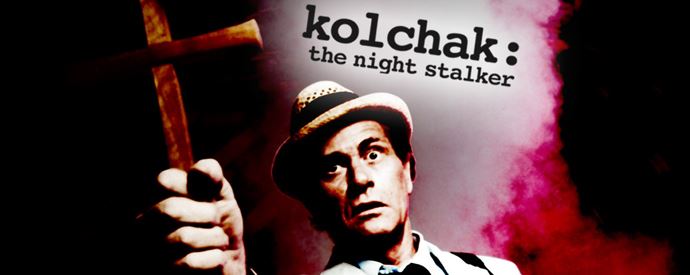
By Philip Schweier
October 29, 2014 - 13:09
Forty
years ago, a few of the girls in my 4th grade class invited me to sign their
petition against violence on TV. They were interested in more family-oriented
programming, such as The Waltons or Little House on the Prairie.
Among the shows they wanted to see axed from the airwaves was my then-favorite,
The Night Stalker.
The Night Stalker, violent? Turn on the news and you hear of shootings
and murders. That’s violence. Turn on The Night Stalker and see a man
jump off a five-story building, land on his feet, and destroy a couple of
police cars before running away. That’s fantasy, and I was a huge fan.
Naturally, I refused to sign the petition. Being 10-year-old girls, they
reported my refusal to sign to our teacher. My suspicion is that this whole
episode started as some form of teaching opportunity. The teacher hoped to
redirect some these girls' excess energy by making them part of the diplomatic
process: come up with a petition, collect some signatures, mail it off to the
people in charge, and await the results.
Consequently, the teacher encouraged me to sign, rather than recognize my
individual right not to. Nevertheless, I wasn’t about be party to the
cancellation of what was my favorite show at the time.
The Night Stalker – later re-titled Kolchak: The Night Stalker –
featured Carl Kolchak, a perennially down-on-his-luck reporter for the
Chicago-based Independent News Service. The series chronicled his never-ending
run-ins with all manner of vampires, werewolves, demons and other nightmarish
creatures.
The series began as an unpublished manuscript, The Kolchak Papers, by
Jeff Rice. As the book made the rounds among publishers, it gained some
traction in Hollywood, where Richard Matheson adapted Rice’s manuscript to
film. Universal produced it for ABC, airing in January 1972. It was a huge
success, drawing the highest ratings ABC Movie of the Week to date, and the
screenplay earned Matheson an Edgar Award from the Mystery Writers of America.
In the story, Carl Kolchak is a Las Vegas reporter covering a series of grisly
murders. He comes to attribute the slayings to a vampire, Janos Skorzeny.
Needless to say, this stretched the boundaries of credibility, as evidenced by
the constant haranguing of Kolchak’s editor, Tony Vincenzo, played by Simon
Oakland. Kolchak eventually manages to defeat the vampire, but his story – and
his ambition of resurrecting his career – is squashed and the authorities
run him out of town.
Much of the movie’s appeal can be credited to Darren McGavin, who
starred as Kolchak. When he first read the script, he saw potential others did
not, and his casting contributed significantly to Kolchak’s development as a
character – voice, mannerisms and wardrobe. In an interview published in Mark
Dawidziak’s The Night Stalker Companion, McGavin said,
"Well, when you’re working that fast in television, you have to draw on
yourself. You use who you are to a greater extent than you would in a play or a
film."
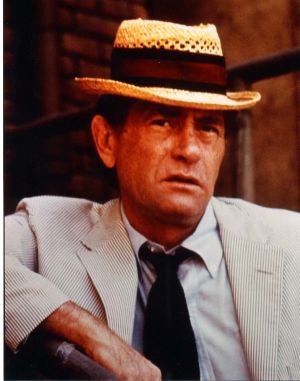
Darren McGavin as Carl Kolchak
McGavin helped establish a back-story for the character. Once a reputable
journalist, Kolchak had been fired from a New York newspaper years ago. Since
then, he hadn’t bought a new suit or car, and was still wearing the same
rumpled seer-sucker suit and straw hat, still driving the same ’66 Mustang.
The success of the film led to a sequel, produced and directed by Dan Curtis of
Dark Shadows fame. To sell his vampire story, Carl attends a newspaper
convention where he is reunited with his former boss, Tony Vincenzo, who reluctantly
hires him to cover a series of slayings in Seattle. Carl’s investigation
discovers the murders mimic another series from 21 years prior – and another
series 21 years before that – dating all the way back to 1880s.
Once again, Kolchak discovers supernatural forces are at work, only to have his
article killed and to find himself jobless. “You’re gonna love New York,” he
says at the end, suggesting there are more adventures in store.
A third film was planned, but instead evolved into a TV series. It is reported
that Curtis was approached to produce the series, but declined. Matheson also
chose to pass on the project. “Frankly, I was sort of relieved,” he says in The
Night Stalker Companion. “We’d had so much trouble coming up with a
story for The Night Strangler... couldn’t imagine how they could come up
with a new monster every week.”
However, McGavin still believed in Carl Kolchak. He made a verbal agreement
with Sid Sheinberg, president of MCA/Universal TV to co-own the series, in
partnership with Universal. McGavin and his wife, Kathie Browne, were to
produce the series through their company, Taurean Films. However, when the show
was announced in the April 24, 1974 issue of Variety, “No producer has
been set on the hour series.”
McGavin wanted the series to be a reverse of The Fugitive – Kolchak would chase vampire Janos Skorzeny around
the country. However, McGavin was overruled. Instead, Kolchak and Vincenzo are
now working for the Chicago-based Independent News Service, and the series
adopted a monster-of-the-week format, in which Chicago became the hub for a
variety of horrors: rippers, zombies, swamp monsters, etc.
In addition to Vincenzo, there were added supporting players: Ron
Updyke (Jack Grinnage) – Kolchak's effete rival at INS whom Kolchak repeatedly
refers to as “Uptight;” Emily Cowles (Ruth McDevitt), an elderly puzzles
and advice columnist known as "Miss Emily,” and often sympathetic
toward Kolchak; Monique Marmelstein (Carol Ann Susi) an enthusiastic intern
whose uncle is highly placed in the management of the Independent News Service;
and Gordy "The Ghoul" Spangler (John Fiedler), a helpful morgue
attendant.
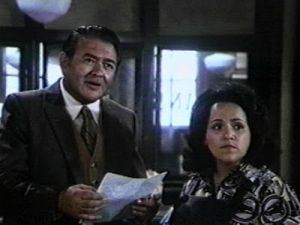
Simon Oakland (l) as Tony Vincenzo, and Carol Ann Susi (r) as Monique Marmelstein. Susi currently plays Howard's mother on The Big Bang Theory
However, the series featured a variety of police captains, chief detectives,
commissioners, and other authority figures aggravated by Kolchak’s outlandish
investigative theories. A number of popular TV actors of the day guest starred,
including Scatman Crothers, Dick Van Patten, Larry Storch, Alice Ghostley,
Victor Jory, Phil Silvers, Bernie Kopell, James Gregory, Hans Conried, Carolyn
Jones, Jackie Mason, Stella Stevens, David Doyle, Jim Backus, Kathleen Freeman,
John Hoyt, Dwayne Hickman, Tom Skerritt, Erik Estrada, William Daniels, Jamie
Farr, Pat Harrington, Larry Linville and Richard Kiel.
A variety of monsters were featured during the course of the 20 produced
episodes, from classics such as vampires, werewolves, mummies and zombies to
more science fiction-related creatures such as a murderous android, an
invisible extraterrestrial, a defrosted caveman, and a subterranean lizard.
Other forms of supernatural beings were drawn from folklore, such as ancient
Mayan and American Indian myths, Hindu legends and a Louisiana bog monster.
Robert Zemeckis and Bob Gale co-authored a modern take on the Headless
Horseman, and another episode dealt with a knight’s suit of armor brought to
life by a spirit.
The series' premiered Friday, Sept. 13, 1974 at 9 p.m. – rarely a
successful time slot. Ratings were mediocre, though there was a reported uptick
midway through the season, saving it from cancellation. Nevertheless, ABC was
reluctant to sacrifice lucrative air time to promote the show.
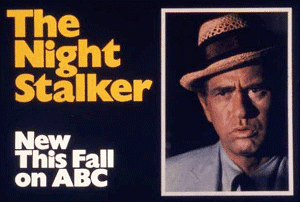
McGavin found himself rewriting scripts and doing much of the work of an
executive producer without getting the full credit and compensation of one.
Scripts were chronically late, leading to issues not just for the actors, but
also logistical problems related to sets, shooting permits, special effects and
other production concerns.
He grew dissatisfied, saying in a 1975 interview, “This is not the show I
started out to do, and rather than try and pump life with a hypodermic needle
into something that’s just dying, I’d rather bury it and put it out of its
misery.”
In The Night Stalker Companion, Kathie Browne, McGavin’s wife and production
partner, says, “Everything was so frantic. There was so much to do and so
little time. Everybody always was under a lot of pressure. There was lots of
location shooting – out at the airport, out in the Valley, out in Pasadena,
always some place. I remember the speed, the pace, the energy.”
“The Night Stalker only lasted one year because I didn't want to do it
any more,” McGavin told the Calgary Herald in March, 1983. “The pain in doing
that show was excruciating. It was shot from 4:00 in the afternoon until
5:00 in the morning.”
After 20 episodes, McGavin asked to be released from his contract. Two scripts
remained to be filmed to fulfill the commitment to the network, but McGavin’s
request was granted in light of the show's dwindling ratings.
Despite its cancellation after only one season, the series has influenced other
programs, such as The X-Files. That show’s creator, Chris Carter, wanted
McGavin to appear as Kolchak in one or more episodes of The X-Files, but
McGavin was unwilling to reprise the character for the show. In 2005, ABC
launched a news series featuring Stuart Townsend as Carl Kolchak, but it was
canceled less than two months later.
Darren McGavin passed away in 2006. Kathie Browne McGavin says,
“The people who really love The Night Stalker love Kolchak because he
never gives up. He’s fighting, always fighting. You can take the monsters and
take them to be anything you want – the government, big business, corrupt
officials. Their hero comes at the end, beaten up but ready to go on fighting
another day. I think Darren has a lot of that in his own personality.”
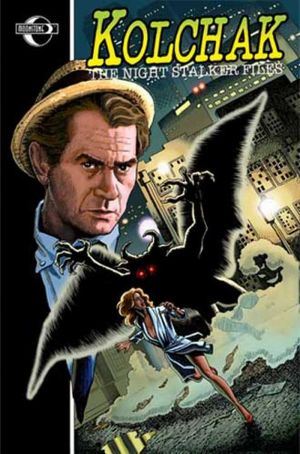
This assessment is recognized in one of McGavin’s other iconic roles, that of
the dad in A Christmas Story. Legend has it he spearheaded the campaign
for the film's release, despite the misgivings of MGM executives. His belief in
the movie laid the foundation for it to become a beloved holiday favorite.
Beginning in 2003, Moonstone Books began publishing a comic book series,
leading to two short fiction anthologies, The Night Stalker Chronicles,
and Kolchak: The Night Stalker Casebook. Moonstone has also
published The Lovecraftian Horror; The Lovecraftian Damnation; A Black and
Evil Truth; and The Lost City, all by C. J. Henderson.
After more than 40 years, Carl Kolchak has become a cult hero among fans of
science fiction, fantasy and horror. His iconic wardrobe has made his costume
instantly recognizable at parties and conventions. Despite the efforts of those
4th grade girls, like the monsters he often battled, Carl Kolchak is hard to
keep down.